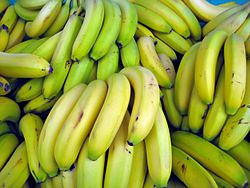Cavendish banana subgroup



Cavendish banana subgroup is a banana cultivar subgroup originating from Vietnam and China.[1]
Taxonomy and nomenclature
Cavendish bananas are a subgroup of the triploid (AAA) cultivars of Musa acuminata.[2]
The Cavendish banana subgroup is named after the 'Dwarf Cavendish' cultivar within its subgroup, which is named in honour of William Cavendish, 6th Duke of Devonshire, who acquired an early specimen, and from whose hothouses the cultivars were first developed for commercial exploitation worldwide.
Cavendish cultivars are distinguished by height and features of the fruits,[3][4] and different cultivars may be recognized as distinct by different authorities. The most important clones for fruit production include: 'Dwarf Cavendish', 'Grande Naine', 'Lacatan', 'Poyo', 'Valéry', and 'Williams' under one system of cultivar classification.[3] Another classification includes: 'Double', 'Dwarf Cavendish', 'Extra Dwarf Cavendish', 'Grande Naine', 'Pisang Masak Hijau' ('Lacatan'), and 'Giant Cavendish' as a group of several difficult-to-distinguish cultivars (including 'Poyo', 'Robusta', 'Valéry', and 'Williams').[4] 'Grande Naine' is the most important clone in international trade, while 'Dwarf Cavendish' is the most widely grown clone.[4] 'Grande Naine' is also known as the Chiquita banana.[5] Over 250 local names are known for cultivars from the Cavendish subgroup[6]
Uses
Cavendish bananas accounted for 47% of global banana production between 1998 and 2000, and the vast majority of bananas entering international trade.[7]
The fruits of the Cavendish bananas are primarily eaten raw; however, they are also used in baking, fruit salads, fruit compotes, and as a complement to other foods. The outer skin is most often partially green when sold, and turns yellow when it ripens. As it ripens, the starches turn to sugar, making a sweeter fruit. When it reaches its final stage (stage 7), brown/black "sugar spots" develop. When overripe, the skin turns black and the flesh becomes mushy. Bananas ripen naturally until they are picked. Once picked, they no longer turn yellow on their own, and need to be gassed with ethylene to start up ripening again. Most retailers sell bananas in stages 3–6, with stage 4 being the most ideal.
Disease resistance
In mid-2008, reports from Sumatra and Malaysia suggested that Cavendish-like cultivars may be vulnerable to Panama disease.[8]
References
- ^ Persley, G. J.; George, Pamela (1996). "Portfolio of Projects". Banana Improvement: Research Challenge and Opportunity. Washington, D.C.: World Bank Publications. p. 29. ISBN 0-8213-3740-8.
Viet Nam is one of the centers of origin of Musa spp., and has many species, varieties, and clones. ... The banana export trade is primarily based on local varieties of Cavendish cultivars, which originated in Vietnam
- ^ Porcher, Michel H.; Barlow, Snow (2002-07-19). "Sorting Musa names". The University of Melbourne. Retrieved 11 January 2011.
- ^ a b Mohan Jain, S.; Priyadarshan, P. M. (2009). Breeding Plantation Tree Crops: Tropical Species. Springer Science+Business Media, LLC. ISBN 978-0-387-71199-7.
- ^ a b c Ploetz, R. C.; Kepler, A. K.; Daniells, J.; Nelson, S. C. (2007). "Banana and Plantain: An Overview with Emphasis on Pacific Island Cultivars". In Elevitch, C. R. (ed.). Species Profiles for Pacific Island Agroforestry (PDF). Hōlualoa, Hawai'i: Permanent Agriculture Resources (PAR). Retrieved 2013-01-10.
{{cite book}}: Unknown parameter|lastauthoramp=ignored (|name-list-style=suggested) (help) - ^ Voldeck, Lisa Beth (2010). "Indoor Banana Trees". bellaonline.com. Retrieved 12 January 2011.
- ^ "Banana cultivar checklist on ProMusa". Retrieved 28 May 2014.
- ^ Arias, Pedro; Dankers, Cora; Liu, Pascal; Pilkauskas, Paul (2003). The World Banana Economy 1985-2002. Rome: Food and Agriculture Organization of the United Nations. ISBN 92-5-105057-0. ISSN 1810-0783. Retrieved 30 July 2013.
- ^ Ploetz, R. C. 2005. Panama disease, an old nemesis rears its ugly head: Part 1, the beginnings of the banana export trades. Plant Health Progress doi:10.1094/PHP-2005-1221-01-RV.

